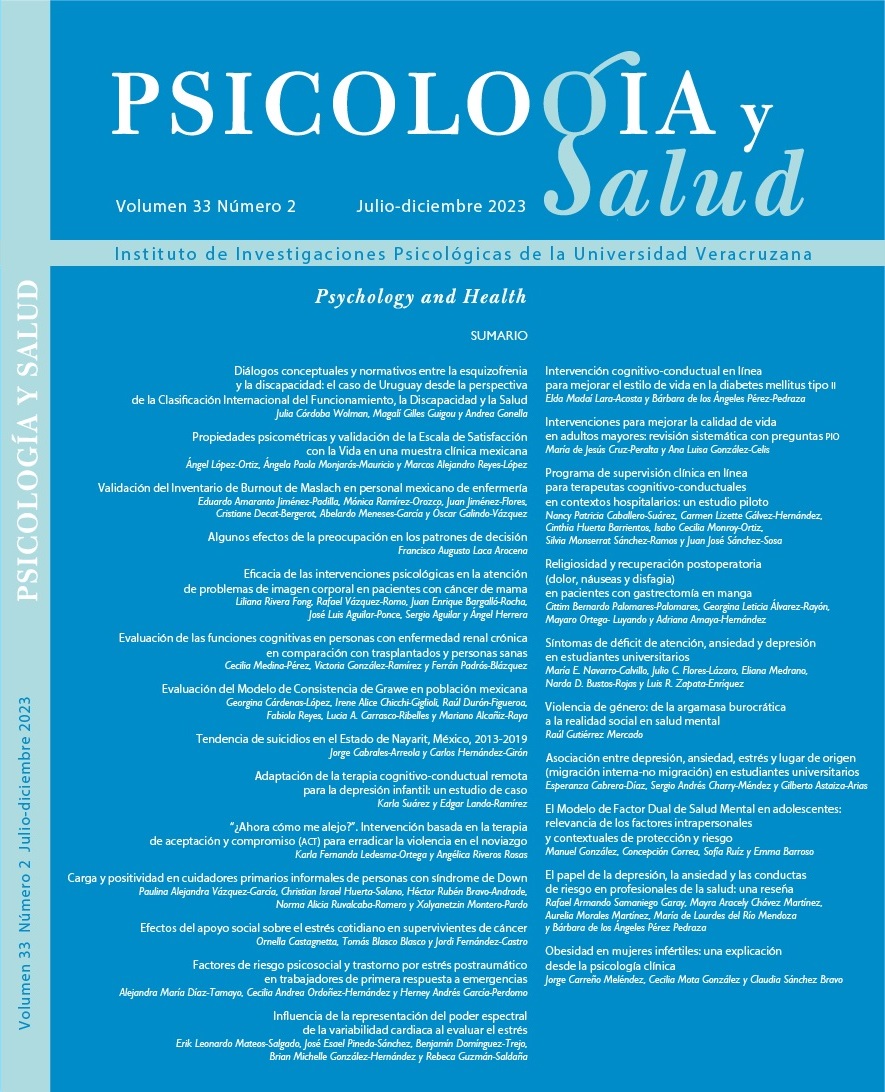Abstract
Mental disorders represent one of the leading social problems in the world, revolving around several theoretical models to support integrative interventions. Grawe’s Consistency Model states that four basic psychological needs must be satisfied to maintain mental health. These needs refer to attachment, self-esteem, control or self-efficacy, and decreased pain and increased pleasure. Although some studies have analyzed the relationship between these constructs, few studies focused on evaluating Grawe’s model. Objective. The present study aimed to evaluate the relationship between the four basic psychological needs in the Mexican population. Sixty-one participants: 29 men and 31 women, were administered a series of scales measuring the abovementioned four constructs. Results. Results showed significant correlations in the different scales and subscales. Discussion. The present study allowed a greater understanding of the basic psychological needs raised in Grawe’s model in the Mexican population; however, the study had some limitations and cautionary aspects for future studies.
References
Ainsworth, M.D.S., Blehar, M.C., Waters, E. y Wall, S. (1978). Patterns of attachment: A psychological study of the Strange Situation. Lawrence Erlbaum.
Bandura, A. (1982). Self-efficacy mechanism in human agency. American Psychologist, 37(2), 122.
Bartholomew, K. y Horowitz, L.M. (1991). Attachment styles among young adults: a test of a four-category model. Journal of Personality and Social Psychology, 61(2), 226.
Bellón, J.A., Delgado, A., De Dios L, J. y Lardelli, P. (1996). Validez y fiabilidad del Cuestionario de Apoyo Social Funcional Duke-UNC-11. Atención Primaria, 18, 153-163.
Berking, M., Holtforth, M.G. y Jacobi, C. (2003). Changes in clinically relevant goals and therapy outcome: A study with inpatients undergoing cognitive behavioral therapy. Psychotherapie, Psychosomatik & Medizinsche Psychologie, 53(3), 171-177.
Bowlby, J. (1973). A secure base: Clinical applications of attachment theory (Collected papers). Tavistock.
Broadhead, W.E., Gehlbach, S.H., De Gruy, F.V. y Kaplan, B.H. (1988). The Duke–UNC Functional Social Support Questionnaire: Measurement of social support in family medicine patients. Medical Care, 26(7), 709-723. Doi: 10.1097/00005650-198807000-00006.
Carver, C.S. (1997). You want to measure coping but your protocol’too long?: Consider the Brief Cope. International journal of Behavioral Medicine, 4(1), 92.
Carver, C.S. y White, T.L. (1994). Behavioral inhibition, behavioral activation, and affective responses to impending reward and punishment: the BIS/BAS scales. Journal of Personality and Social Psychology, 67(2), 319.
Cassidy, J. (1990). Theoretical and methodological considerations in the study of attachment and the self in young children. En T. M. Greenberg, D. Cicchetti y M. Cummings (Eds.): Attachment in the preschool years: Theory, research, and intervention (pp. 87-119). Chicago University Press.
Chicchi-Giglioli, I.A., Pravettoni, G., Sutil M., D.L., Parra, E. y Alcañiz R., M. (2017). A novel integrating virtual reality approach for the assessment of the attachment behavioral system. Frontiers in Psychology, 8, 959. Doi: 10.3389/fpsyg.2017.00959.
Cooper, M.L., Shaver, P.R. y Collins, N.L. (1998). Attachment styles, emotion regulation, and adjustment in adolescence. Journal of Personality and Social Psychology, 74(5), 1380.
De León R., C.A. y García M., M. (2016). Escala de Rosenberg en población de adultos mayores. Ciencia Psicológica, 10(2), 119-127.
Elliot, A.J. y Covington, E.A. (2001). Approach and avoidance motivation. Educational Psychology Review, 13(2), 73-92. Doi: 10.1023/A:1009009018235.
Erdle, S. y Rushton, J.P. (2010). The general factor of personality, BIS–BAS, expectancies of reward and punishment, self-esteem, and positive and negative affect. Personality and Individual Differences, 48(6), 762-766.
Gorrese, A. y Ruggieri, R. (2013). Peer attachment and self-esteem: A meta-analytic review. Personality and Individual Differences, 55(5), 559-568.
Gratz, K.L. y Roemer, L. (2004). Multidimensional assessment of emotion regulation and dysregulation: Development, factor structure, and initial validation of the difficulties in emotion regulation scale. Journal of Psychopathology and Behavioral Assessment, 26(1), 41-54.
Grawe, K. (2004). Psychological therapy. Hogrefe Publishing.
Grawe, K. (2007). Neuropsychotherapy: How the neurosciences inform effective psychotherapy. Lawrence Erlbaum Associates Publishers.
Hervás, G. y Jódar, R. (2008). Adaptación al castellano de la Escala de Dificultades en la Regulación Emocional. Clínica y Salud, 19(2), 139-156.
King, L.A. y Emmons, R.A. (1990). Conflict over emotional expression: Psychological and physical correlates. Journal of Personality and Social Psychology, 58(5), 864.
Kogut, E. (2016). Adult attachment styles, self-efficacy, and causal attributional style for achievement-related failures. Learning and Individual Differences, 50, 64-72.
Kring, A.M., Smith, D.A. y Neale, J.M. (1994). Individual differences in dispositional expressiveness: Development and validation of the Emotional Expressivity Scale. Journal of Personality and Social Psychology, 66(5), 934.
Lane, J., Lane, A.M. y Kyprianou, A. (2004). Self-efficacy, self-esteem and their impact on academic performance. Social Behavior and Personality, 32(3), 247-256.
Melero, R. y Cantero, M.J. (2008). Los estilos afectivos en población española: un cuestionario de evaluación del apego adulto. Clínica y Salud, 19(1), 83-100.
Meyer, B., Olivier, L. y Roth, D.A. (2005). Please don’t leave me! BIS/BAS, attachment styles, and responses to a relationship threat. Personality and Individual Differences, 38(1), 151-162.
Mikulincer, M. y Shaver, P. (2005). Mental representations of attachment security: Theoretical foundation for a positive social psychology. En M. W. Baldwin (Ed.): Interpersonal cognition (pp. 233-266). The Guilford Press.
Mikulincer, M. y Shaver, P. R. (2012). An attachment perspective on psychopathology. World Psychiatry, 11(1), 11-15.
Piemontesi, S.E. (2012). The emotional expressivity scale validation in Argentine university students. Suma Psicológica, 19(1), 59-68.
Rojas B., C.A., Zegers P., B. y Förster M., C.E. (2009). La Escala de Autoestima de Rosenberg: validación para Chile en una muestra de jóvenes adultos, adultos y adultos mayores. Revista Médica de Chile, 137(6), 791-800. Doi: 10.4067/S0034-98872009000600009.
Rosenberg, M. (1965). Society and the adolescent self-image. Princeton. University Press.
Rotter, J.B. (1966). Generalized expectancies for internal versus external control of reinforcement. Psychological Monographs: General and Applied, 80(1), 1.
Schwarzer, R. y Jerusalem, M. (2010). The General Self-efficacy Scale (GSE). Anxiety, Stress, and Coping, 12(1), 329-345.
World Health Organization (2011). Global burden of disease. WHO Health Statistics and Health Information Systems. WHO.

